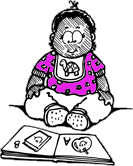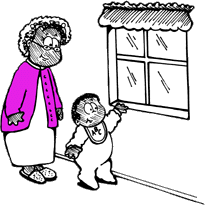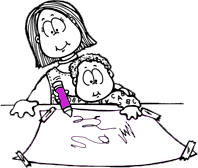|
Activities and Ideas for Crawlers
Listening and Talking: Crawlers and walkers are learning that it's fun to be with other people.

- Help your baby learn about taking turns the way people do when they talk with each other. Sing songs and play games such as Peek-a-Boo, hiding the toy under the blanket, and handing objects back and forth. At first you may have to take more turns than the baby does.
- When your baby babbles, talk back. Make the same sounds the baby makes or teach new ones.
- Respond when your baby wants to play a familiar game: "Oh good, you brought me the ball. Let's sit down and roll it on the carpet."
Crawlers and walkers use gestures and actions to "talk" to you.
- Respond when your baby shakes his or her head, points to something out of reach, or lifts his or her arms. Talk about what the baby seems to want to say. "Do you want to get out of my lap? Here's a wet cloth so you can wipe your hands."
- Name the things your baby points to. "That's a muffin. Do you want a muffin?" Say the words for feelings and actions. "Aunt Nikki is funny, isn't she?" "I saw you climb up the stairs."
How to help your baby's caregiver: Talk with your caregiver about the gestures your baby uses to ask questions, make requests, say hello, and get someone's attention. Ask the caregiver to tell you the words and phrases your baby seems to understand. |
Crawlers and walkers learn to say a few words.
- Show your excitement when your baby begins to talk. Talk with your baby about the names of objects, actions, and feelings.
- Look at and listen to things together with your baby. Talk about what you see and hear. "See the bird. She's flying up to her nest in the tree. Do you hear the truck? I'll lift you up to the window so you can see it."
- Listen carefully to your baby's tone of voice. The baby may use the same word to mean different things. For example:

Alphonso stands at the window looking outside. He asks, "Sandy?" Grandma says what she thinks Alphonso means, "Where did Sandy go?" Then Grandma answers his question, "Sandy went outside."
Reading
Crawlers and walkers can join in during story times.
- Read with your baby every day. Babies enjoy short, simple stories, rhymes, and songs. Read the same books over and over, and also read new ones. Because your baby probably won't pay attention for long, it's best to read for a short while many times during the day.
- Point to the pictures and name the objects. Ask your baby to point and name things, too. Smile, change your tone of voice, nod, and make faces when you read. Your baby will have fun copying your words and actions.
- Let your baby choose the books and set the pace for reading. Read books with thick, cardboard pages so that the baby can turn the pages. You don't have to look at every page, read the whole page, or finish the book at one sitting.
How to help your baby's caregiver: Volunteer to help the caregiver make a book about the things babies do at child care. Paste photographs or simple drawings on cardboard, cover with clear adhesive paper, punch holes in the cover and finished pages, and bind with a piece of string. Make new books during the year. |
Developing Muscles For Writing
Crawlers and walkers can use their fingers, thumbs, and hands.
- When your baby learns to move a bottle or a toy from one hand to the other, hand a toy to the baby and say, "Now give it back to me."
- Provide toys and household items that the baby can put together and take apart, fit inside each other, or fill and empty (e.g., large plastic snap beads, a set of plastic measuring cups, or a box filled with bean bags).
- Encourage your baby's independence. When your baby can pick up small objects with the index finger and thumb, offer finger foods such as pieces of banana. Grasping food will build the muscles in the baby's hands and fingers. Your baby will feel good about doing things without help. Allow the baby to pull off socks and shoes, and give the baby a spoon to help feed him- or herself.
How to help your baby's caregiver: Ask the caregiver to suggest some inexpensive household items that are safe play materials for crawlers and walkers. |
 Crawlers and walkers can scribble with crayons and markers.
Crawlers and walkers can scribble with crayons and markers.
- Give your baby large, nontoxic crayons and large pieces of scrap paper such as brown paper bags from the grocery store. At first, babies often put the crayons in their mouths, but show your baby how to use the crayons to make marks on paper.
- Introduce large, nontoxic markers when your baby has learned to keep crayons out of the mouth most of the time.
|
|
|